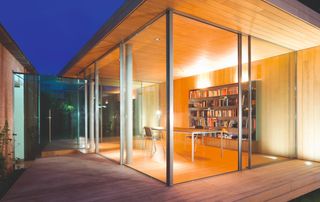Expert reveals the best acoustic insulation for homes — and why to avoid soundproofing
Energy efficiency expert Tim Pullen takes a closer look at the best forms of acoustic insulation to absorb noise and put a stop to sound pollution in your home

If you're tired of dealing with unwanted noise invading your peace and quiet at home, you may want to consider soundproofing your house by installing acoustic insulation.
Whether it's noisy neighbours, street sounds, or the hustle and bustle of daily life causing disturbances, installing acoustic insulation can make a world of difference to your living space and your general sense of calm.
Below, energy efficiency expert, Tim Pullen, shares his advice for the besthome insulationmethods to absorb noise and put a stop to sound pollution.
Soundproofing vs sound absorption
There is a distinct difference between soundproofing and sound absorption.
Soundproofingis what you have in a recording studio — a construction system that aims to prevent all sound from entering or leaving the room. For sound proofing to work it requires specialist materials (in walls, floors, ceilings) that capture sound to prevent it passing or rebounding. Most houses do not want that. You may do if you are a music teacher working from home and the music room needs to be soundproof, but that is the exception.
Generally we do not want that ‘dead’ quality that soundproofing tends to bring. What we want is soundabsorptionwhich can be achieved with a product of materials that are relatively flexible (or elastic) with a high density. In the video below, Phil Lyons, Senior Technical Adviser at The Soundproofing Store, explains the difference between soundproofing and sound absorption:
What are the different types of acoustic insulation?
Wood fibre insulationis a good insulator – it’s a dense and elastic wool-like material.
Cellulose andsheep’s wool insulationare also good sound absorbing, natural materials.
Mineral wool insulationis a good option for the cost-conscious as it will get the job done.
Hard foam insulation types(polyurethane, polyisocyanurate, etc.) are essentially made up of rigid bubbles of air, which serves as a great thermal insulator but a poor sound insulator as they lack both density and elasticity.
How to install acoustic insulation in timber walls
Ideally you will be installing insulation into a timber frame, as wool insulation materials can be easily inserted between the studs. Having said that, the studs themselves will tend to carry sound and in more severe cases it would be good to ‘decouple’ the timber frame. That is, have two separate, thinner frames with a gap between — the frames are still filled with insulation material and linked with a sound resilient clip which prevents noise travelling from one side of the wall to the other.
In both cases 100mm of insulation would be used — as a single batt in a standard wall or as two 50mm batts in a decoupled wall. Usually 50mm is the minimum for sound insulation purposes and 100mm the optimum.
If in doubt that 100mm will be sufficient then think about specialist materials like Knauf Earthwool Sound Shield(available to buy at Wickes) as it is a little denser than mineral wool or other fiberglass insulation.
Installing acoustic insulation in masonry walls
With masonry construction the options are more limited, as partition walls tend to be solid block construction with no cavity. Equally, being solid also means that noise transition is less likely. If there is, or likely to be, a noise problem then lining with an acoustic plasterboard like Resonate Resoboard or Gyproc Soundbloc (available at B&Q) or will do the job. It only has to be applied to one side of the wall (as it is quite expensive), that is the side producing the most noise.
Insulating a ceiling from noise above follows the same method as insulating a timber frame wall — install 100mm of wool-type insulation between the joists. In a retrofit where taking up the floor or dropping the ceiling is not feasible, then acoustic plasterboard will again be the answer. Acoustic plasterboard is a good deal thicker than standard boards and if that cannot be accommodated then simply installing mass with another layer of standard plasterboard will certainly help.
Other ways to mitigate sound pollution

Windows and Glazing
If road or external noise is the issue, then insulating cavity walls with mineral wool or cellulose will help but the main culprit will be the windows. Double ortriple-glazed windowswill definitely be needed, which is now standard in a new build anyway. In more severe cases you might require acoustic glazing, which uses glass of different thicknesses and hardness and with a wider gap between the panes.
他们成功的关键隔音玻璃the gap. Double glazing with a 50mm gap between the panes will be as effective as triple glazing, but fitting that into the frame could be a problem. When in doubt, call a specialist for a project specific assessment.
Sound absorbing solutions

Alongside acoustic insulation there are several sound absorbing solutions that can help minimise noise in your home, such as installing timber slatted wall panels and ceiling rafts in your living spaces.
"Have you ever been in a room where it just sounds echoey, and you can't hear clearly? That's because of something called reverberation" explains Phil Lyons fromThe Soundproofing Store."Think of it like a rubber ball bouncing around a room. Sound does the same thing in spaces with hard, smooth surfaces, bouncing around and making everything seem loud and muddled. That's why sometimes, in busy restaurants for instance, it's hard to hear the person right in front of you".
"Sound absorbing materials can step in to soak up that bouncing sound, making rooms sound clearer and quieter. This is most useful in places where clear sound is essential, like in home offices, but it also applies to other areas of our homes".
By installing a timber slatted wall (like the one pictured above) you can reduce excess noise and keep sound levels to a minimum.

Phil's background as a professional musician means his knowledge of soundproofing and sound absorption is second to none. He is an expert in everything from soundproofing a room in your home, to a music studio and everything in between.
The key takeaways
Getting to grips with noise pollution has plagued homeowners and builders for years. So much so that it is now dealt with underPart E of the Building Regulations.There's a plethora of specialist soundproofing products on the market, but in the majority of domestic situations, standard products should do the trick,
Of course, there will be exceptions – like a music room or a house under a flightpath – but these are exceptions and in those cases the advice of an expert, designing a specific solution for that house will be the cheapest and most effective option.
Two rules for acoustic insulation
For the more typical house there are only two rules when it comes to acoustic insulation:
Make sure there is no direct airborne route for the noise to travel through.In reality this means ensuring the insulation material is properly installed so that it fills the whole space and cannot slump.
Use any of the wool-type materials, or cellulose.There are plenty of good reasons to use natural insulation material but mineral wool is cheaper and will get the job done.
If you think your home would benefit from soundproofing, you might also find it helpful to read our guide tosoundproofing ceilings.
Get the Homebuilding & Renovating Newsletter
Bring your dream home to life with expert advice, how-to guides and design inspiration, direct to your inbox.
Tim is an expert in sustainable building methods and energy efficiency in residential homes and writes on the subject for magazines and national newspapers. He is the author ofThe Sustainable Building Bible,Simply Sustainable Homes and Anaerobic Digestion - Making Biogas - Making Energy: The Earthscan Expert Guide.
His interest in renewable energy and sustainability was first inspired by visits to the Royal Festival Hall heat pump and the Edmonton heat-from-waste projects. In 1979
this initial burst of enthusiasm lead to him trying (and failing) to build a biogas digester to convert pig manure into fuel, at a Kent oast-house, his first conversion project.
移动2002年在南威尔士的分,providing as it did access to a wider range of natural resources, fanned his enthusiasm for sustainability. He went on to install renewable technology at the property, including biomass boiler and wind turbine.
He formally ran energy efficiency consultancy WeatherWorks and was a speaker and expert at the Homebuilding & Renovating Shows across the country.
- Gabriella DysonAssistant Editor
Most Popular
Bring your dream home to life with expert advice, how-to guides and design inspiration, direct to your inbox.
Thank you for signing up to Homebuilding. You will receive a verification email shortly.
There was a problem. Please refresh the page and try again.
